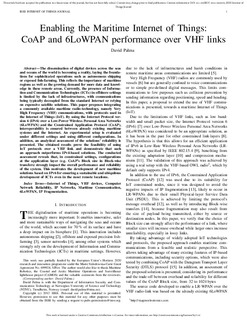| dc.contributor.author | Palma, David | |
| dc.date.accessioned | 2019-02-12T14:33:53Z | |
| dc.date.available | 2019-02-12T14:33:53Z | |
| dc.date.created | 2018-09-25T16:22:50Z | |
| dc.date.issued | 2018 | |
| dc.identifier.citation | IEEE Internet of Things Journal. 2018, . | nb_NO |
| dc.identifier.issn | 2327-4662 | |
| dc.identifier.uri | http://hdl.handle.net/11250/2585074 | |
| dc.description.abstract | The dissemination of digital devices across the seas and oceans of the world is becoming a reality, laying the foundations for sophisticated operations such as autonomous shipping or exposed fish-farming. This reflects the importance of maritime regions as well as the growing demand for more data and knowledge in these remote areas. Currently, the presence of information and communication technologies (ICTs) in offshore settings is limited by the lack of infrastructures, with communications being typically decoupled from the standard Internet or relying on expensive satellite solutions. This paper proposes integrating a commonly available maritime radio-technology, namely very high frequency (VHF) communications, with protocols used in the Internet of Things (IoT). By using the Internet Protocol version 6 (IPv6) over a low-power wireless personal area networks and the constrained application protocol (CoAP), interoperability is ensured between already existing maritime systems and the Internet. An experimental setup is evaluated under different settings and using different configurations. In addition, an analytical assessment of the solutions’ reliability is presented. The obtained results prove the feasibility of using IoT protocols over a VHF link and demonstrate that such an approach outperforms IPv4-based solutions. The conducted assessment reveals that, in constrained settings, configurations at the application layer (e.g., CoAP’s block size in Block-wise transfers) strongly impact the overall performance and reliability of the system. This motivates the development of new maritime solutions based on IPv6 for ensuring a sustainable and ubiquitous development of ICTs even in the most remote locations. | nb_NO |
| dc.language.iso | eng | nb_NO |
| dc.publisher | Institute of Electrical and Electronics Engineers (IEEE) | nb_NO |
| dc.rights | Navngivelse 4.0 Internasjonal | * |
| dc.rights.uri | http://creativecommons.org/licenses/by/4.0/deed.no | * |
| dc.title | Enabling the Maritime Internet of Things: CoAP and 6LoWPAN performance over VHF links | nb_NO |
| dc.title.alternative | Enabling the Maritime Internet of Things: CoAP and 6LoWPAN performance over VHF links | nb_NO |
| dc.type | Journal article | nb_NO |
| dc.type | Peer reviewed | nb_NO |
| dc.description.version | publishedVersion | nb_NO |
| dc.source.pagenumber | 8 | nb_NO |
| dc.source.journal | IEEE Internet of Things Journal | nb_NO |
| dc.identifier.doi | 10.1109/JIOT.2018.2868439 | |
| dc.identifier.cristin | 1613547 | |
| dc.description.localcode | This work is licensed under a Creative Commons Attribution 3.0 License. For more information, see http://creativecommons.org/licenses/by/3.0/. | nb_NO |
| cristin.unitcode | 194,63,30,0 | |
| cristin.unitname | Institutt for informasjonssikkerhet og kommunikasjonsteknologi | |
| cristin.ispublished | true | |
| cristin.fulltext | original | |
| cristin.qualitycode | 1 | |

